Report on Translocation Experiments at Findhorn
What follows is an important report by local lichenologist Heather Paul on experiments to mitigate the effects of development at the Park Ecovillage Findhorn involving translocation (physical movement from the development site to a suitable area out of harm’s way) of some species, particularly the rare Matt Felt Lichen (Peltigera malacea).
The report is long and detailed, often with reference to Latin names of species as few common names exist, but it shows the considerable care taken to safeguard and work with our very special local environment. Do have a read of it to discover a little history about this work, the passion and expertise of those involved and the positive, ground-breaking results that this work is yielding.
Jonathan Caddy, FHT Chair.
Background – The Land and 2008 Lichen Survey
The land to the north and east of Findhorn village supports many ground-dwelling lichens. The sunny beach car park has short turf intermingled with sandy and stony areas. The remaining area is mobile dune, with areas of stable sand and shingle ridges.
Unlike Culbin Forest on the west side of the River Findhorn, and Roseisle Forest to the east, Findhorn dunes have not not been afforested, although there is significant self-seeded and encroaching growth of Scots Pine, Lodgepole pine,gorse and broom. The dunes are mostly sand and shingle and heath, which is now a very rare habitat in the UK.
In 2008 the Findhorn Dunes Trust commissioned lichenologists Sandy and Brian Coppins to undertake a three-day Lichen Survey. This led to the publication of a detailed report which highlighted the importance of Findhorn for lichens growing on the ground, on pebbles and on heather stems, and included some notable species.
https://www.findhornhinterland.org/ecology/lichen-survey/
Peltigera malacea – an Endangered and Nationally Rare lichen – was recorded at Findhorn dunes in 2004 by Bryan Edwards and Joe Hope. In 2008 it was recorded widely across the area, growing on the sandy ground. Peltigera malacea is blue-green when damp but brown and curled up when dry. The surface is downy. The underside is whitish at the edges, sometimes mottled, but brown-black near the centre with rhizines and veins mostly absent. The apothecia are brown-red, often with crenulate margins.
-
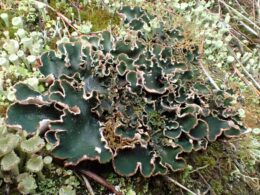
-
Damp Peltigera malacea at Findhorn with Cladonia sp.
-
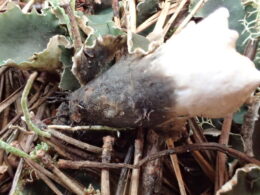
-
Underside of Peltigera malacea
-
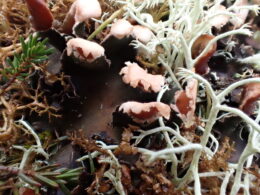
-
Crenulate apothecia on dry brown Peltigera malacea
-
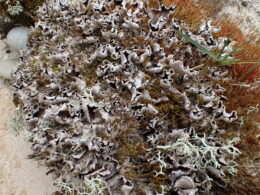
-
Dry curled up brown Peltigera malacea with mottled underside.
At the time of the survey it was understood that outline planning permission had been given to build houses in part of the dune system next to existing housing at the Ecovillage Findhorn. The Lichen Survey suggested “Possible mitigation to redress the destruction of the habitat and populations of Peltigera malacea”. This would involve taking “material from the site where development is to destroy the habitat, and find suitable locations elsewhere in the Dunes to re-locate the lichen”. The translocation needed to be “carefully recorded with follow-up visits (monitoring) to check on success or failure. Some monitoring of Peltigera malacea in situ should be made as a control.” It was not known whether this type of translocation had been attempted before so it would be a useful exercise.
2012 – The Initial Translocation Experiment
In 2012 an ecological appraisal of the proposed West Whins development area was undertaken by local ecologist Sean Reed of Reed Ecology. This recommended retaining natural habitat where possible and translocating some lichen-rich dune heath where not possible. Planning permission was granted on this basis and on 24-10-2012, 6 local residents removed some Peltigera malacea by cutting squares of lichens in the sand, similar to turves of grass when laying or removing a lawn. In total 80 turves were moved a very short distance (from NJ04896380 to NJ04956387) to a bare, sandy south-facing site below a gorse bank.
The turves were placed in the ground with the edges mostly covered by sand. The area was 5mx9m. It was ringed with pebbles and a sign was erected.
The site was monitored regularly. There was little disturbance over the next 8 years. Some small pine seedlings and gorse were removed. In July 2016, 85 Peltigera malacea were counted, ranging from tiny new lobes to some that were old and decaying. Some were fertile. The largest was 27x19cm.
The list of lichens recorded included Peltigera membranacea, P.hymenina, Cladonia gracilis, C. furcata, C.diversa, 4 other Cladonia sps., Stereocaulon condensatum, Leptogium palmatum, Cetraria aculeata. Hypogymnia physodes and Evernia prunastri grew on heather stems. Pebbles supported Rhizocarpon reductum, Xanthoria mougeotii and Hypogymnia physodes. There was growth of moss, 2 heathers – Calluna vulgaris and Erica cinerea, and sheep sorrel – Rumex acetosella . Ants and rabbit droppings were present. The rabbits are integral to this habitat and help to keep the heather and other vegetation short so lichens are not shaded.
2016-2018 – Assessment of the Initial Experiment
By July 2016 it was felt that the translocation had been successful with a slight increase in Peltigera malacea. Observations at Findhorn seem to indicate that the conditions here are suitable for Peltigera malacea to thrive. Sometimes it grows at the edge of gorse, in moss and heather, where it may benefit from rain seepage, but many have been recorded in open sunny areas. Apothecia (spore-bearing structures) are frequent and there must be many spores in the local environment.
The Lichen Survey suggested measuring the growth rate of Peltigera malacea. The site to do this was chosen partly because it was easy to find again, eg at the edge of a path (NJ050640). However this meant it was vulnerable to disturbance, although destruction of the 1 metre high bank by a motorbike in late 2016 was unexpected.
In this east-facing sandy bank on 13-2-16 there was one large Peltigera malacea 49x19cms growing closely with Cladonia portentosa and Leptogium palmatum along with grass, gorse and moss and 13 more Peltigera malacea, varying from 4×1.5 cm to tiny specimens 1x1cm. There were few other lichens apart from a Peltigera hymenina and Baeomyces rufus. Most of these lichens and the wooden labels marking the lichens were destroyed when the motorbike cut a deep groove through the bank.
By 2018 new thalli of Peltigera malacea were seen but recording was not resumed. On 12-7-21, 18 were observed in approximately one metre length of the bank, the largest being 8x8cms. In July 2023 15 thalli were recorded – none of them fertile – and Cladonia sp and Baeomyces rufus. No Leptogium palmatum has been seen here since the destruction.
2019–2024 Planning and Implementing a Larger Translocation Experiment
In March 2019 an Ecological Impact Assessment of the adjoining North Whins proposed development area was completed, again by Reed Ecology. The site included mostly gorse-covered sand dunes with a much smaller area of dune heath and areas of bare sand and shingle, which included the 2012 translocation area.
The assessment report concluded that “the proposed development site is of local ecological significance, but must be considered as part of a larger area of high-value sand dune habitats which are of national significance for lichens”.
Regarding dune heath, the report considered the “direct loss of rare and fragile dune heath and shingle containing nationally scarce lichen species”, “potential damage to dune heath on adjoining land through spread of tree seeds from landscape planting within the proposed development”, “the unavoidable loss of around 1.5 hectares of natural dune scrub”.
The report referred to concerns in the 2008 Lichen Survey about public pressure on the wider dune heath, and the encroachment of gorse and trees. It also referred to the 2012 lichen translocation.
Suggested measures to address these concerns included:
“Translocation of dune heath to a protected area within the site”
“Enhancement of existing dune heath areas within the site”
“Restoration of 2 areas of dune heath adjacent to the site”
“Removal of encroaching pine trees and no new tree planting within 5m of all dune heath”
“Minimal tree-planting to achieve adequate landscape screening”
“Creation of around 0.3ha of (high conservation value) dune heath/ acid grassland within the site”
“Advice to new residents on the ecological sensitivities of the site and surrounding area”.
The report considered “that the full schedule of mitigation, compensation and enhancement measures will deliver a development with no significant adverse ecological effects over-all. A positive impact (net ecological gain) is predicted for the dune heath and acid grassland. the two highest priority habitats on-site.”
The Moray Council gave planning permission, citing the lichen translocation plan in its approval.
The ecological impact assessment stated “the areas, to which the lichens are to be translocated, should be turf-stripped to bare sand, with no humus”. Turves will be lifted and translocated the same day, supervised by an ecologist between September and March. They will be clearly demarcated. There will be free access to rabbits and deer and will have signage to identify its fragility. The site is to be monitored by a qualified ecologist in years 1, 3 and 5 and advice given to the developer.”
This translocation was on a much larger scale than 2012 and involved creating a new area from a south-facing slope covered in gorse. Heavy machinery was used to dig out the gorse by the roots and to lessen the steepness of the slope. The site was chosen because it fitted in with the housing plan, and had suitable sandy soil and an open aspect. The area to be translocated was measured and a low open wooden fence was erected around three sides. The preparation involved considerable time and expense by the developers, Duneland Ltd and by Greenleaf Design and Build.
In February 2020 Duneland Ltd arranged a translocation day, advertising this in the local community and providing welcome refreshments. Approximately 30 people were involved for most of one day.
The same method was used as in 2012. Wooden boards were used to carry the lichen turves.The lichen turves were joined together this time. People were shown Peltigera malacea and there was an attempt to select this for translocation but no count was made due to the amount of lichen moved. Pebbles from the original translocation site were placed around the area, just inside the wooden rail fence – but not underneath it.
By the end of the day the translocation was complete. An area approximately 150m2 was filled, leaving some sand around the edges for further work. The whole area set aside for the translocation was approximately 245m2. Almost immediately Covid restrictions then stopped further work.
During winter, pebbles in the sand rose to the surface so the remaining bare area became sandy and stoney. Over the next one to two years the lichens appeared to be growing well. There was some scuffing up of Cladonia sps. The site appeared undamaged by footfall.
On a few separate occasions in 2021 and 2022 some further lichen turves were cut and laid in the bare areas. This time it was decided to leave sand and pebbles between each turf to allow lichens to spread naturally on the bare sand and pebbles.
When cutting the new turves it was noticed that where turves had been removed previously there were new young Peltigera malacea growing on the bare soil.
On 12-7-21, after a day of heavy rain, the site was visited to record. Peltigera malacea is much easier to observe when damp. A total of 36 were recorded from the 2020 translocation and 36 from the turves moved in February 2021. The Peltigera malacea varied in size – 25x24cms, 16x15cms, 13x10cms, 10x9cms, 8x12cms and smaller. Some were fertile.
Other lichens included Peltigera membranacea, P. hymenina, Hypogymnia physodes, and Evernia prunastri on dead heather, Cladonia ciliata and other Cladonia sps, Cetraria aculeata and Stereocaulon condensatum. No Leptogium palmatum was seen – this lichen disintegrates very easily when attempting to move it. Rabbit droppings were in evidence and some scuffing up of the bare soil.
In July 2021,flowering plants were growing amongst the lichens and at the edge of the lichen translocation site . Some of these will have been as a result of disturbance of the soil. They included sheep sorrel and a large groundsel. It was noted that although sheep sorrel grows widely at Findhorn in grassland, it does not seem to grow out on the main sand and shingle dune heath.
By October 2022 there was less evidence of flowering plants, but some small gorse seedlings were growing. The lichens appeared to be growing well.
Separately, as stated in the plan for the creation of new dune heath, in February 2020 two areas of gorse and dune heath were scraped back to pure sand, and pines were removed to create new dune heath. The area of dune heath restored away from the main development site is 0.35ha. Lichens are very slowly beginning to colonise. Neither area is part of the main lichen-rich dune heath and both are ringed by gorse and trees but already had a significant lichen presence that was untouched by the clearance.
The lichens seen here in March 2023 include Cladonia zopfii, and other Cladonia sps, Dibaeis baeomyces, Stereocaulon condensatum, Cetraria aculeata, Evernia prunastri, Peltigera malacea and P membranacea. There is evidence of deer and rabbits.
By November 2024 a number of lichen species were continuing to grow on the ground in the translocation area. A total of 35 individual Peltigera malacea were counted. There was some reduction in the number of this lichen in the translocation area but there is evidence of regrowth. This lichen is also beginning to colonise the bare sand at the other newly created bare sand area. Some of these are young lichens, showing that this is continuing to thrive. It is planned to monitor the growth rate of this lichen.
Other lichens are beginning slowly to grow on some of the bare sand at the translocation site, such as Cladonia zopfii and Stereocaulon condensatum – both are Nationally Scarce.
The Future
How long will it be before the bare pebbles and sand are colonised by lichens? It is likely to take some years as lichen growth will be slow and there will be some inevitable disturbance.
Will wild plants growing on and next to the translocation continue to grow here?
It is hoped the community living around the translocation will take an interest in its maintenance which will be minimal – eg occasional weeding if needed, removal of small gorse regrowth.
Will there be more disturbance from people and domestic pets once the houses are completed? Will the rabbits continue to live here, keeping plant growth down?
There is to be a small service road next to the translocation site and new houses are to be built nearby. What effect will this have on the lichens?
It is planned that signage of the translocation site, and information about this, will be provided to the new residents. This could act as an introduction to the wider dune heath habitat at Findhorn, providing education about its ecological sensitivities and enabling people to enjoy a habitat that at times can appear desolate. It can be difficult for people to appreciate the biodiversity on their doorstep when the flora and fauna are so small.
Conclusion
It is felt that the work done so far has shown that translocation of terricolous lichens can be successful. It should be noted the translocation was to a habitat that was already supporting these lichens.
South of Ecovillage Findhorn the habitat for some of these ground-dwelling lichens quickly becomes unsuitable. There are pockets of open areas at Kinloss, Roseisle and further east at Lossiemouth. Findhorn remains a rare open area and is part of the coastal heathland corridor. This habitat is of priority conservation value and this work contributes to the preservation of some of its local biodiversity.
Many thanks to Sean Reed, who prepared the two ecological assessments and mitigation plans and to Duneland Ltd and Greenleaf Design and Build who were prepared to support this with resources and to all who took part. It is hoped that this demonstrates how it is possible to work together to produce a positive outcome for nature.
Heather Paul
March 2025
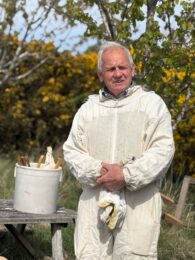
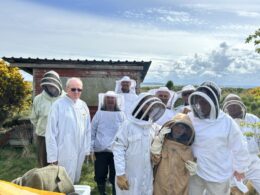 Opportunities for visitors to get involved in our regular Thursday morning (10am to 12.30pm) bee inspections are just one of the things we will be offering as part of the partnership between Findhorn Bay Holiday Park (FBHP) and FHT, along with Family Sharing Nature mornings, volunteering opportunities on the land as well as our regular tours. The most significant benefit to the charity will be FBHP using their booking system to offer our 12 camping pads to visitors when not in use by FHT volunteers. We are excited about this as it will open up the good work we do to more people (FBHP had over 10,000 visitors last year), bring in another potential source of income and provide a different experience to those that choose this camping option. It is an experiment and so let’s see how it goes this season. There have been a number of enquiries from students wishing to become long-term volunteers this summer and they may be able to help out with this project. FHT felt it was time to tighten up on how we involve volunteers so have done a little housekeeping to produce improved volunteering forms and agreements.
Opportunities for visitors to get involved in our regular Thursday morning (10am to 12.30pm) bee inspections are just one of the things we will be offering as part of the partnership between Findhorn Bay Holiday Park (FBHP) and FHT, along with Family Sharing Nature mornings, volunteering opportunities on the land as well as our regular tours. The most significant benefit to the charity will be FBHP using their booking system to offer our 12 camping pads to visitors when not in use by FHT volunteers. We are excited about this as it will open up the good work we do to more people (FBHP had over 10,000 visitors last year), bring in another potential source of income and provide a different experience to those that choose this camping option. It is an experiment and so let’s see how it goes this season. There have been a number of enquiries from students wishing to become long-term volunteers this summer and they may be able to help out with this project. FHT felt it was time to tighten up on how we involve volunteers so have done a little housekeeping to produce improved volunteering forms and agreements. 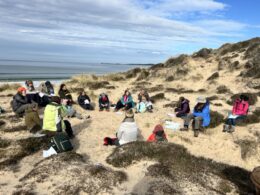 Another partnership that is developing is with the educational charity Growing2Gether, where we are offering Sharing Nature games up at our Woodland Shelter, facilitated by educator Roy Simpson. This is so that the secondary school pupils can come as a group and experience something outdoors to build confidence and gain some skills. Two groups have visited so far: Alness Academy on the 13th May and Inverness High on the 19th May. Roy also offered a free Sharing Nature workshop earlier in the month that was well attended by 17 local educators, including a number from Wild Things! One outcome was that Ada Valeria came forward to apprentice with Roy. This will ensure skills are passed on and Roy will have help delivering a summer programme of events.
Another partnership that is developing is with the educational charity Growing2Gether, where we are offering Sharing Nature games up at our Woodland Shelter, facilitated by educator Roy Simpson. This is so that the secondary school pupils can come as a group and experience something outdoors to build confidence and gain some skills. Two groups have visited so far: Alness Academy on the 13th May and Inverness High on the 19th May. Roy also offered a free Sharing Nature workshop earlier in the month that was well attended by 17 local educators, including a number from Wild Things! One outcome was that Ada Valeria came forward to apprentice with Roy. This will ensure skills are passed on and Roy will have help delivering a summer programme of events.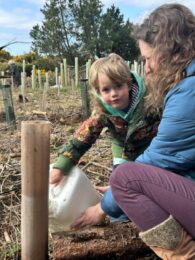
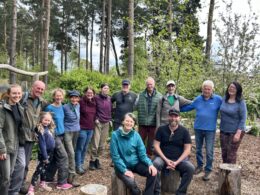
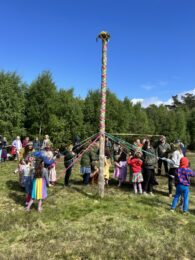 There’s so much more I could talk about: the final landscaping and completion of the new sanctuary – see the story on FHT’s involvement; another successful Maypole dancing and ceremony event on the Green Burial area, led by Draeyk and attended by over 90 people as part of the community-wide Mayday celebration; progress with the land transfers from Duneland Ltd and the Findhorn Foundation, which are well on their way; and the printing of green burial folders which now have legacy information included. But suffice it to say that we are busy and thriving as your local charity custodians who care for and help people connect and learn from the land.
There’s so much more I could talk about: the final landscaping and completion of the new sanctuary – see the story on FHT’s involvement; another successful Maypole dancing and ceremony event on the Green Burial area, led by Draeyk and attended by over 90 people as part of the community-wide Mayday celebration; progress with the land transfers from Duneland Ltd and the Findhorn Foundation, which are well on their way; and the printing of green burial folders which now have legacy information included. But suffice it to say that we are busy and thriving as your local charity custodians who care for and help people connect and learn from the land.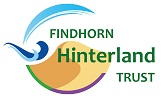

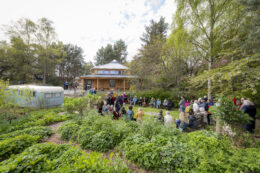
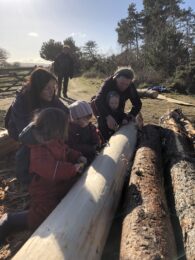 FHT is a great believer in never making a good catastrophe go to waste! That’s what happened when storm Arwen struck on the 25 November 2021, resulting in over one hundred trees in Wilkies Wood being blown down. Our Land Manager, Kajedo, set to work felling the trees and I pulled them out using our wee grey Fergie tractor. They were to be either milled by Ben then stacked and covered by FHT volunteers, or stripped, covered and stored as round construction wood by a merry band of young and old within our community.
FHT is a great believer in never making a good catastrophe go to waste! That’s what happened when storm Arwen struck on the 25 November 2021, resulting in over one hundred trees in Wilkies Wood being blown down. Our Land Manager, Kajedo, set to work felling the trees and I pulled them out using our wee grey Fergie tractor. They were to be either milled by Ben then stacked and covered by FHT volunteers, or stripped, covered and stored as round construction wood by a merry band of young and old within our community.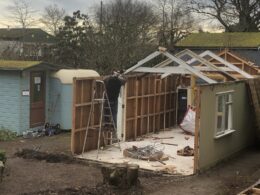 By November we were starting to remove the wooden sheds that had become important and well-used offices as the community grew in the 1970s and 80s, and were still in operation before the fires. First to go was the cooks office on 8 November, the computer office on 10 November and finally the Park Campus office on 2 February 2023. The General Office and food shed were finally removed by the site contractor’s machines on 5 October 2023, after many years of faithful service to the community.
By November we were starting to remove the wooden sheds that had become important and well-used offices as the community grew in the 1970s and 80s, and were still in operation before the fires. First to go was the cooks office on 8 November, the computer office on 10 November and finally the Park Campus office on 2 February 2023. The General Office and food shed were finally removed by the site contractor’s machines on 5 October 2023, after many years of faithful service to the community.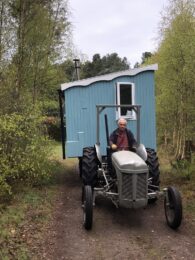 Almost instantly we had a shepherd’s hut to be used for FHT long-term volunteers on the land! After installing a wood stove and covered verandah, as well as repainting and re-roofing it back at the Conservation Hub, we moved it into Wilkies Wood on 28 April 2023 and had the grand opening as part of that year’s May Day celebrations.
Almost instantly we had a shepherd’s hut to be used for FHT long-term volunteers on the land! After installing a wood stove and covered verandah, as well as repainting and re-roofing it back at the Conservation Hub, we moved it into Wilkies Wood on 28 April 2023 and had the grand opening as part of that year’s May Day celebrations.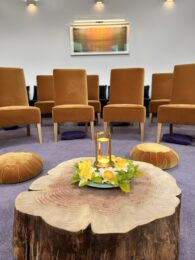 Another FHT contribution was to remove a large redwood tree that was beginning to threaten Cornelia Featherstone’s house situated on the way up to the Universal Hall. It had been felled by a local tree surgeon, after permission had reluctantly been given, helped by the intention to use the wood as part of the new sanctuary build. The logs that were removed in March 2023 have yet to be converted to furniture, but the remaining stump had a 20cm section cut off and sanded – it is now the centerpiece for candles and flowers in the new sanctuary. It looks and feels so appropriate that the tree is honoured in this way.
Another FHT contribution was to remove a large redwood tree that was beginning to threaten Cornelia Featherstone’s house situated on the way up to the Universal Hall. It had been felled by a local tree surgeon, after permission had reluctantly been given, helped by the intention to use the wood as part of the new sanctuary build. The logs that were removed in March 2023 have yet to be converted to furniture, but the remaining stump had a 20cm section cut off and sanded – it is now the centerpiece for candles and flowers in the new sanctuary. It looks and feels so appropriate that the tree is honoured in this way.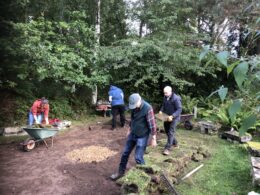 A now unseen but significant effort by FHT volunteers was helping to dig the large soakaway for the building. This involved taking up the turf on most of the original garden lawn, stacking it out of the way for the digger to come in and create a huge hole, which was then filled with gravel before the turf was re laid. At this time, a midden of shells and burnt wood was discovered when digging the sanctuary foundations. I informed archaeologist Michael Sharpe – you can
A now unseen but significant effort by FHT volunteers was helping to dig the large soakaway for the building. This involved taking up the turf on most of the original garden lawn, stacking it out of the way for the digger to come in and create a huge hole, which was then filled with gravel before the turf was re laid. At this time, a midden of shells and burnt wood was discovered when digging the sanctuary foundations. I informed archaeologist Michael Sharpe – you can 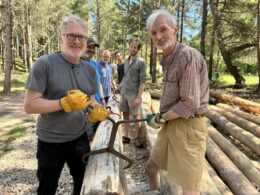 It wasn’t until 23 April 2024 that the building foundations were dug and the concrete poured on 26 April. In June the selected structural poles, which had been stored in anticipation of the build, were moved down to the FHT Conservation Hub for final preparation, before they were moved to site and and erected in September. We also used the tractor to deliver sarking stored up in Wilkies Wood that was used in the roof.
It wasn’t until 23 April 2024 that the building foundations were dug and the concrete poured on 26 April. In June the selected structural poles, which had been stored in anticipation of the build, were moved down to the FHT Conservation Hub for final preparation, before they were moved to site and and erected in September. We also used the tractor to deliver sarking stored up in Wilkies Wood that was used in the roof.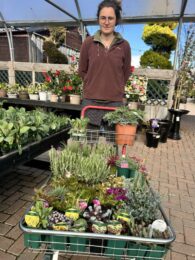 It was special to go to Greens Nursery in Nairn on 9 April 2025 and take time to select the plants to enhance the building and surroundings. Long-term community member John Willorner and I had asked if we could collect a few of the whisky barrel planters from Cluny Hill Hotel, as a symbolic connection to this place that had housed thousands of guests for the community since it was bought in 1975. We loaded them onto the Findhorn Foundation bus along with the soil. By the time they were looking magnificent with the new plants in them, Cluny had been sold after 50 years of community service – we were glad we had taken time to gather this small memento.
It was special to go to Greens Nursery in Nairn on 9 April 2025 and take time to select the plants to enhance the building and surroundings. Long-term community member John Willorner and I had asked if we could collect a few of the whisky barrel planters from Cluny Hill Hotel, as a symbolic connection to this place that had housed thousands of guests for the community since it was bought in 1975. We loaded them onto the Findhorn Foundation bus along with the soil. By the time they were looking magnificent with the new plants in them, Cluny had been sold after 50 years of community service – we were glad we had taken time to gather this small memento.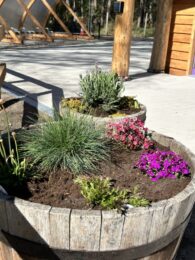 Recently I heard a long-term community member say it was such a pity that people could not get involved in the building of the sanctuary, as had been the case in the 1970s with the Universal Hall. I was wondering where they were when the call for help went out! I am personally satisfied with what the charity has been able to offer our local community and very pleased that we could fulfil one of our charitable purposes, which is to help build local community, in this way.
Recently I heard a long-term community member say it was such a pity that people could not get involved in the building of the sanctuary, as had been the case in the 1970s with the Universal Hall. I was wondering where they were when the call for help went out! I am personally satisfied with what the charity has been able to offer our local community and very pleased that we could fulfil one of our charitable purposes, which is to help build local community, in this way.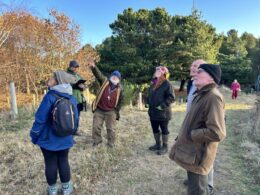 Findhorn’s sand dunes were once part of the second largest dune system in the whole of Europe, but now only very small fragments of that wild ecosystem remain. Because the Hinterland is such a small fragment of a very scarce ecosystem, we have created a conservation plan to preserve and nourish this special environment and all the species that still survive here. The plan is called a Local Biodiversity Action Plan (LBAP), and for me personally, it helped me appreciate just how many rare and endangered species we have on our doorstep. Do have a look at it on the Trust’s
Findhorn’s sand dunes were once part of the second largest dune system in the whole of Europe, but now only very small fragments of that wild ecosystem remain. Because the Hinterland is such a small fragment of a very scarce ecosystem, we have created a conservation plan to preserve and nourish this special environment and all the species that still survive here. The plan is called a Local Biodiversity Action Plan (LBAP), and for me personally, it helped me appreciate just how many rare and endangered species we have on our doorstep. Do have a look at it on the Trust’s 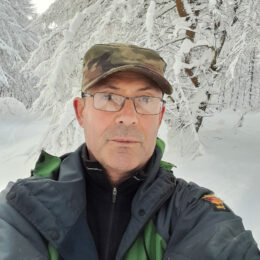
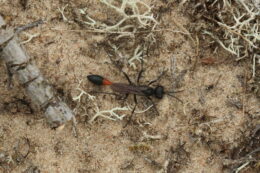
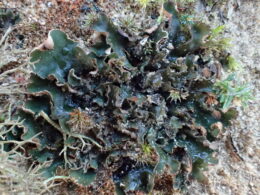
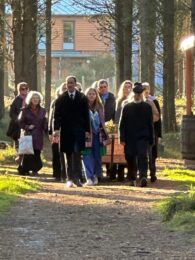 Recently I was asked about the climate impacts of green burials compared to cremation. This set me to investigating the emissions of the four main body disposal methods. Given the growing awareness around these issues, it’s interesting to compare how they rank.
Recently I was asked about the climate impacts of green burials compared to cremation. This set me to investigating the emissions of the four main body disposal methods. Given the growing awareness around these issues, it’s interesting to compare how they rank.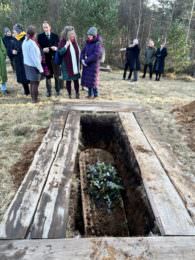 Green burial stands out as Scotland’s most environmentally and culturally compelling body disposal method, offering significant benefits over traditional burial, cremation, and emerging options like resomation. With a carbon footprint of just 10-50kg CO₂e – compared to 100-400kg CO₂e for traditional burial and 200-300kg CO₂e for gas-powered cremation – green burial minimises emissions through its chemical-free, low-energy process and biodegradable materials.
Green burial stands out as Scotland’s most environmentally and culturally compelling body disposal method, offering significant benefits over traditional burial, cremation, and emerging options like resomation. With a carbon footprint of just 10-50kg CO₂e – compared to 100-400kg CO₂e for traditional burial and 200-300kg CO₂e for gas-powered cremation – green burial minimises emissions through its chemical-free, low-energy process and biodegradable materials.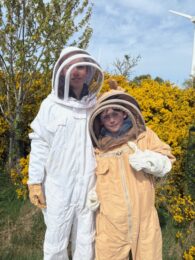
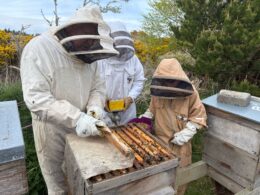
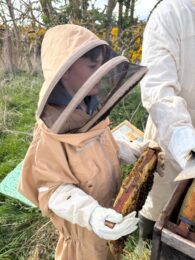
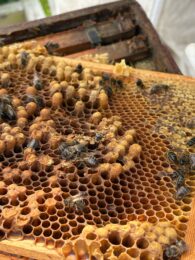
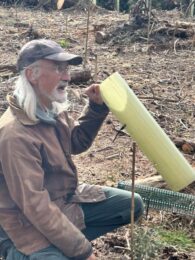
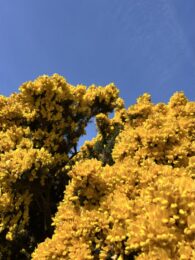
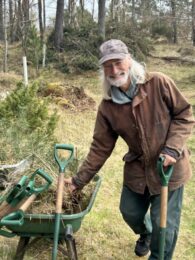
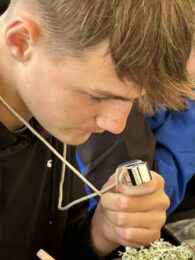
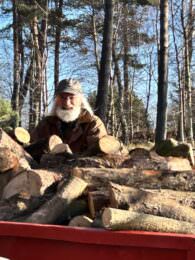
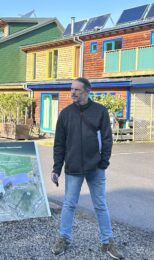
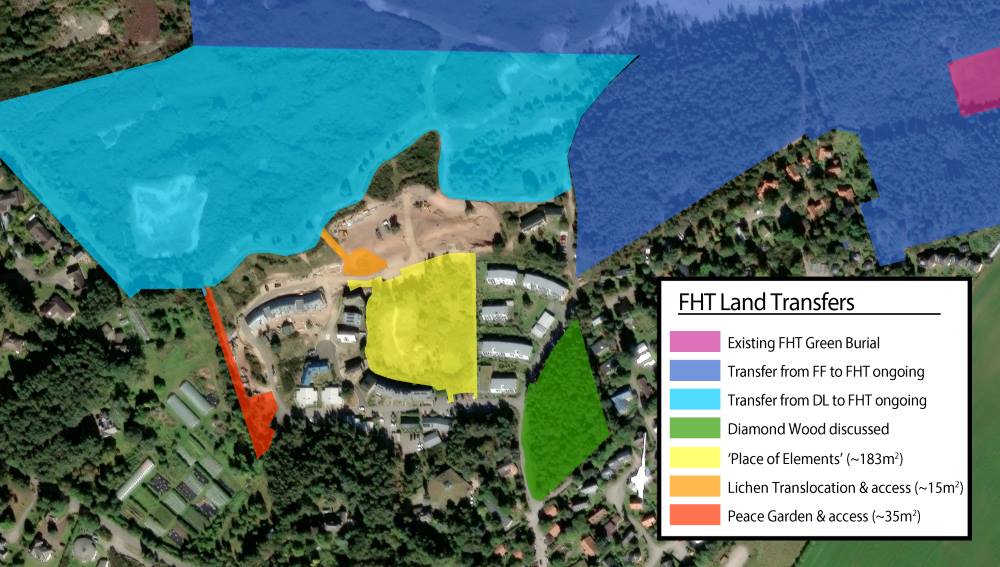
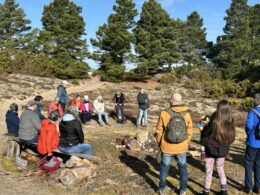




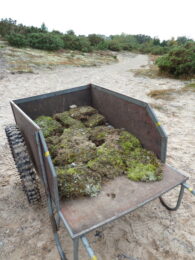
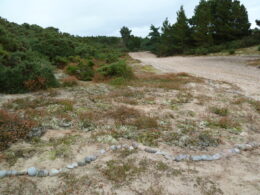
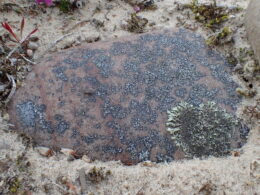
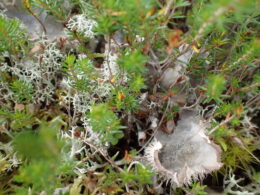
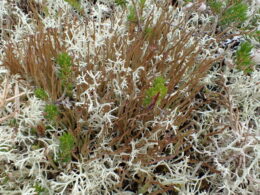
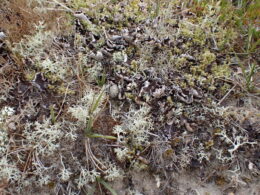
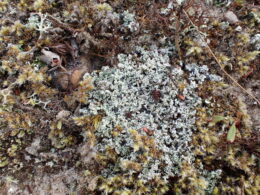
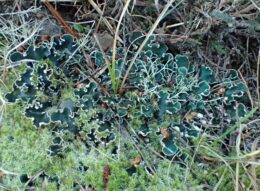
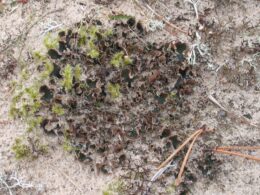
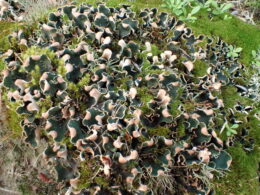
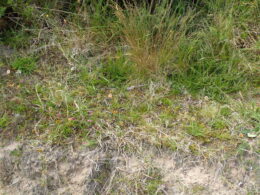
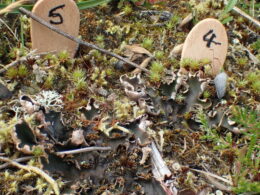
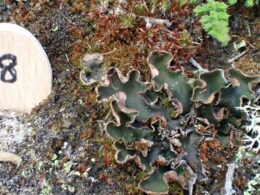
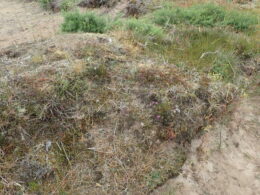
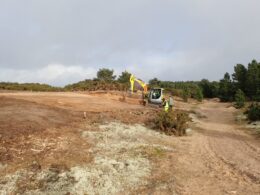
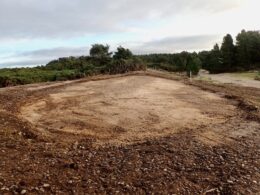
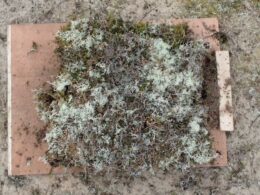
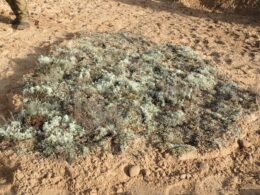
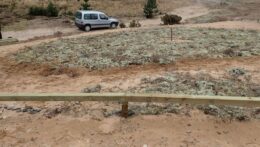
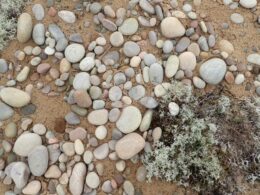
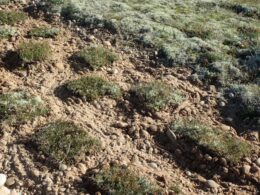
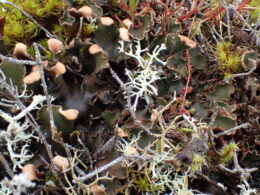
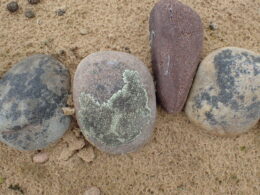
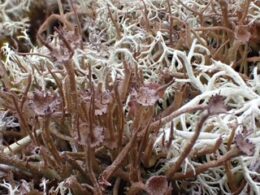
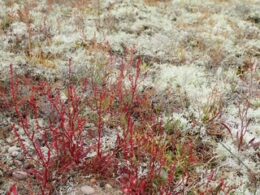
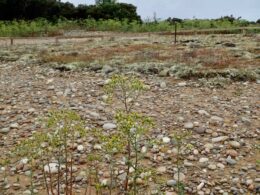
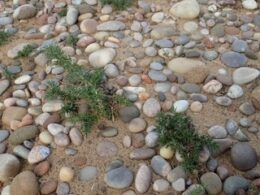
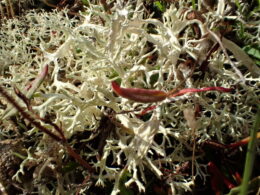
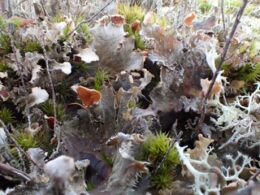
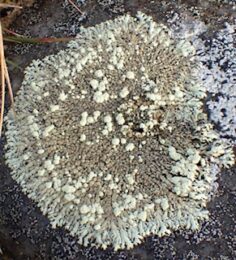
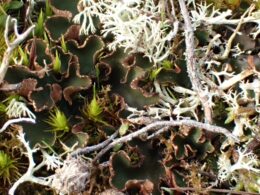
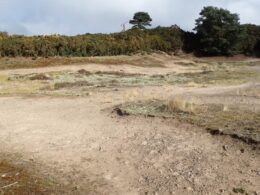
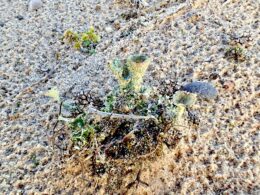















Weaving Maypole magic
One of the FHT’s mottos is never let a disaster go to waste! That was the intent when a storm felled many trees in the Hinterland. That open space is now the Green Burial Ground – and plenty more.
Not only does it have a fire pit, shelter, composting toilets and shower used by campers, it’s also a space for celebrations and community gatherings, such as this joyful dance of the Maypole at Beltane, celebrating fertility, unity and the energy of Spring. Watch a short video of the weaving of the ribbons, symbolising the union of male and female energy.
Video and images by Adelle Horler and Jonathan Caddy